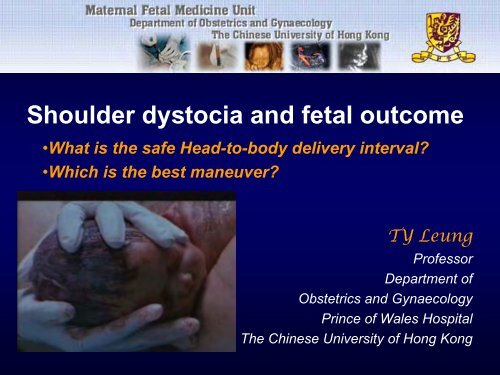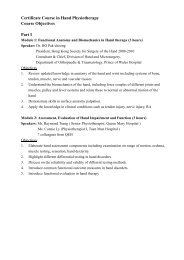You also want an ePaper? Increase the reach of your titles
YUMPU automatically turns print PDFs into web optimized ePapers that Google loves.
<strong>Shoulder</strong> <strong>dystocia</strong> and fetal outcome<br />
•What is the safe Head-to-body delivery interval<br />
•Which is the best maneuver<br />
TY Leung<br />
Professor<br />
Department of<br />
Obstetrics and Gynaecology<br />
Prince of Wales Hospital<br />
The Chinese University of Hong Kong
Brachial Plexus Injury &<br />
<strong>Shoulder</strong> Dystocia<br />
Endogenous<br />
Force<br />
Exogenous Force<br />
• <strong>Shoulder</strong> Dystocia<br />
– Macrosomia<br />
– Gestational DM<br />
– Instrumental Delivery<br />
• Precipiate labour<br />
• Induction / augmentation of labour<br />
• Prolonged labour
Maneuver to relieve<br />
<strong>Shoulder</strong> Dystocia<br />
McRoberts + Suprapubic P<br />
Success<br />
40%
Maneuver to relieve<br />
<strong>Shoulder</strong> Dystocia<br />
Internal Rotation
Maneuver to relieve<br />
<strong>Shoulder</strong> Dystocia<br />
Posterior arm delivery<br />
Fracture<br />
humerus
Maneuver to relieve<br />
<strong>Shoulder</strong> Dystocia<br />
All Four position
Maneuver to relieve<br />
<strong>Shoulder</strong> Dystocia<br />
Fracture Clavicle / Symphysiotomy / Zanvanelli
Maneuver to relieve<br />
<strong>Shoulder</strong> Dystocia<br />
No RCT to prove<br />
which is the best<br />
Increase in<br />
invasiveness
Obstetric Emergency
Which is the best Maneuver<br />
• Based on<br />
– Retrospective observational studies<br />
– Limitations<br />
• Inadequate documentation<br />
• Stepwise approach: no parallel comparison<br />
• Mild shoulder <strong>dystocia</strong> delivered by first<br />
maneuver while more difficult cases left to<br />
subsequent maneuver<br />
• Complications could be related to the final as well<br />
as the preeding maneuver
Which is the best Maneuver
Maneuvers & Success<br />
N=205<br />
M=198 (93.6%)<br />
R=2<br />
P=1<br />
L=4<br />
Succ=51<br />
Fail=147<br />
Succ<br />
Succ<br />
Succ<br />
(25.8%)<br />
R=125<br />
P=22<br />
Succ=90<br />
Succ=14<br />
(72.0%)<br />
(63.6%)<br />
Fail=35→P<br />
Fail=8→R<br />
Succ=27<br />
(77.1%)<br />
Fail=8→M+++<br />
Succ=8<br />
(100%)<br />
Succ=5<br />
(62.5%)<br />
Fail=3→M+++<br />
Succ=3<br />
(100%)
Maneuver & Neonatal Injury<br />
L- S<br />
M- S<br />
MR- S<br />
MP- S<br />
MRP- S<br />
MPR- S<br />
M+++<br />
No. of cases 4 51 90 14 27 5 11<br />
HBDI 1.5 (1-2) 2 (1-2) 2 (2-3) 2 (1.5-3.5) 2 (2-4) 3 (2-<br />
3.5)<br />
5 (4-7)<br />
Brachial<br />
Plexus<br />
injury<br />
Clavicular<br />
Fracture<br />
Humeral<br />
Fracture<br />
3 (75%) 4 (7.8%) 4 (4.4%) 3 (21.4%) 1 (3.7%) 0 (0%) 2 (18.1%)<br />
1 (25%) 2 (3.9%) 5 (5.6%) 1 (7.1%) 0 (0%) 0 (0%) 0 (0%)<br />
0 (0%) 0 (0%) 1 (1.1%) 1 (7.1%) 3 (11.1%) 1 (20%) 1 (9.1%)
Summary of Results<br />
• Lateral traction is associated with high risk of brachial<br />
plexus injury and clavicular fracture<br />
• McRoberts less effective in Asian compared to<br />
Caucasians (25% vs 40%);<br />
• But also lower incidence of brachial plexus injury (7.8%<br />
vs (10-13%)<br />
• Rotational Methods & Posterior arm delivery have<br />
similar successful rate<br />
• Rotational Methods do not increase the risk of brachial<br />
plexus injury<br />
• Posterior arm delivery is associated with high risk of<br />
humeral fracture
McRoberts Maneuver<br />
Why is it less successful in Asian<br />
Hyperflex the hip joints so that the sacrum is lift off!
McRoberts Maneuver<br />
Why is it less successful in Asian<br />
Poor technique<br />
Difference in pelvic anatomy<br />
Lateral traction is still required<br />
Fear of fetal injury > less force<br />
Gherman et al OG 2000
McRoberts & Brachial Plexus Injury<br />
MacKenzie et al OG 2007
McRoberts vs Rotational<br />
Gurewitsch et al AJOG 2005
McRoberts vs Rotational:<br />
1 st choice<br />
McRoberts<br />
Rotational<br />
Approach Maternal Fetal<br />
Skill Less More <br />
Force More Less<br />
Brachial Injury Depends on force Not increased<br />
Success rate 25-40% ~70%<br />
Staff required 3-4 1<br />
HBDI<br />
+Time to call for help
How Fast should we act
Methods<br />
• Retrospective 1995-2009<br />
• 210 cases of shoulder <strong>dystocia</strong> (0.34%)<br />
– 200 cases information available<br />
• All asian (most were chinese)<br />
• Age 31 years old (SD 4.9)<br />
• 97 (48.5%) nulliparous<br />
• 19 (9.5%) gestational / pre-existing diabetes<br />
• Mean gestation at delivery 39.6 (SD 1.1)<br />
• Mean birthweight 3.8kg (SD 0.39kg)<br />
• 66 (31%) >4kg<br />
• 56 (28%) non-reassuring CTG
HBDI vs pH and BE<br />
r = -0.210; P = 0.003) (r = -0.144; P = 0.045)<br />
Drop rate 0.011/min<br />
•Similar to abruption /<br />
cord prolapse<br />
(Leung et al OG 2009)<br />
Leung et al BJOG 2011
AS, pH, BE with HBDI<br />
HBDI<br />
(min)<br />
No. of<br />
cases<br />
AS5<br />
Median<br />
(IQR)<br />
Art pH<br />
Mean<br />
(SD)<br />
Art BE<br />
Mean<br />
(SD)<br />
pH
Training<br />
Draycott et al OG 2008
Conclusion II<br />
• Arterial pH drops with HBDI at rate of 0.011 / minute<br />
• Risk of hypoxia and HIE very low within 4 minutes HBDI<br />
• The tendency in classical teaching of keeping the HBDI<br />
as short as possible is probably related to the<br />
overestimation of the rate of fall of cord pH with time by<br />
Wood et al, and by data in CESDI of UK<br />
• A clear understanding of the risk of acidosis and HIE in<br />
relation to HBDI among the attendants would prepare<br />
them for appropriate stepwise actions, as demonstrated<br />
by the results of labour ward drills for shoulder <strong>dystocia</strong>
Thank you
Green J Reviewers’ Comment
Green J Reviewers’ Comment
BJOG Reviewers’ Comment
Arguements<br />
• Racial difference; increasing Asian population in Western countries<br />
• Decreasing trend in birthweight in cases with shoulder <strong>dystocia</strong>, due to:<br />
el CS for suspected macrosomia<br />
Before 2000 After 2000<br />
Draycott et al OG 2008
Half of the mortalities occurred in 5 minutes<br />
However, it does not equal to 50% mortality rate when<br />
HBDI is within 5 minutes,<br />
as we do not know the number of cases who did not die in 5<br />
minutes!
How fast will Umbilical arterial pH drop<br />
during Head-to-body delivery Interval <br />
Arterial umbilical pH drop by 0.14 per minute during the<br />
Head-to-body body interval (HBDI)<br />
Wood et al JOG Br Comm 1973<br />
Gurewitsch Cln OG 2007
HBDI and pH<br />
Stallings et al AJOG 2001
HBDI and AS5<br />
Allen et al AJOG 2002
Is Time Important
BJOG Reviewers’ Comment
Points to share<br />
• 1 fish, 2 dishes<br />
• Conducting research is Science; writing a paper is<br />
Art; make it published is Business<br />
• Don’t be disappointed when being rejected; take the<br />
valuable advice from the reviewer and improve the<br />
paper<br />
• Clinical retrospective studies still have clinical value<br />
• Challenge the traditional belief
BJOG Reviewers’ Comment (2nd paper)
BJOG Reviewers’ Comment (2nd paper)
BJOG Reviewers’ Comment (2nd paper)
Conclusion II<br />
• Success rate of McRoberts + suprapubic pressure<br />
in our Asian cohort lower than reported<br />
– Different pelvic anatomy<br />
– Ineffective performance Fear of fetal injury<br />
• Rotational vs Posterior arm delivery similar success<br />
rate<br />
• Rotational least risk of fetal injury<br />
– First choice of treatment
Gurewitsch et al AJOG 2005
Gherman et al AJOG 2006
Maneuvers<br />
39.5%<br />
66.2%<br />
Accum:70.7%<br />
McFarland et al IJOG 2006




